Business Administration Report: Office Management and Procedures
VerifiedAdded on 2021/01/03
|15
|4337
|59
Report
AI Summary
This report examines key aspects of business administration, focusing on the consultancy firm Austin Frazer. It delves into legal requirements for office management, typical office services, and procedures for establishing effective office management. The report also covers employer obligations for workplace health and safety, accident and emergency procedures, and individual responsibilities. Furthermore, it explores the purpose and legal implications of meeting minutes, including note-taking techniques. The report also discusses different types of meetings, the roles of participants, and techniques for facilitating meetings. It concludes with an analysis of workload management using targets and budgets, quality management techniques, event planning characteristics, and resource identification. The report emphasizes the importance of compliance, efficiency, and employee welfare in business operations.
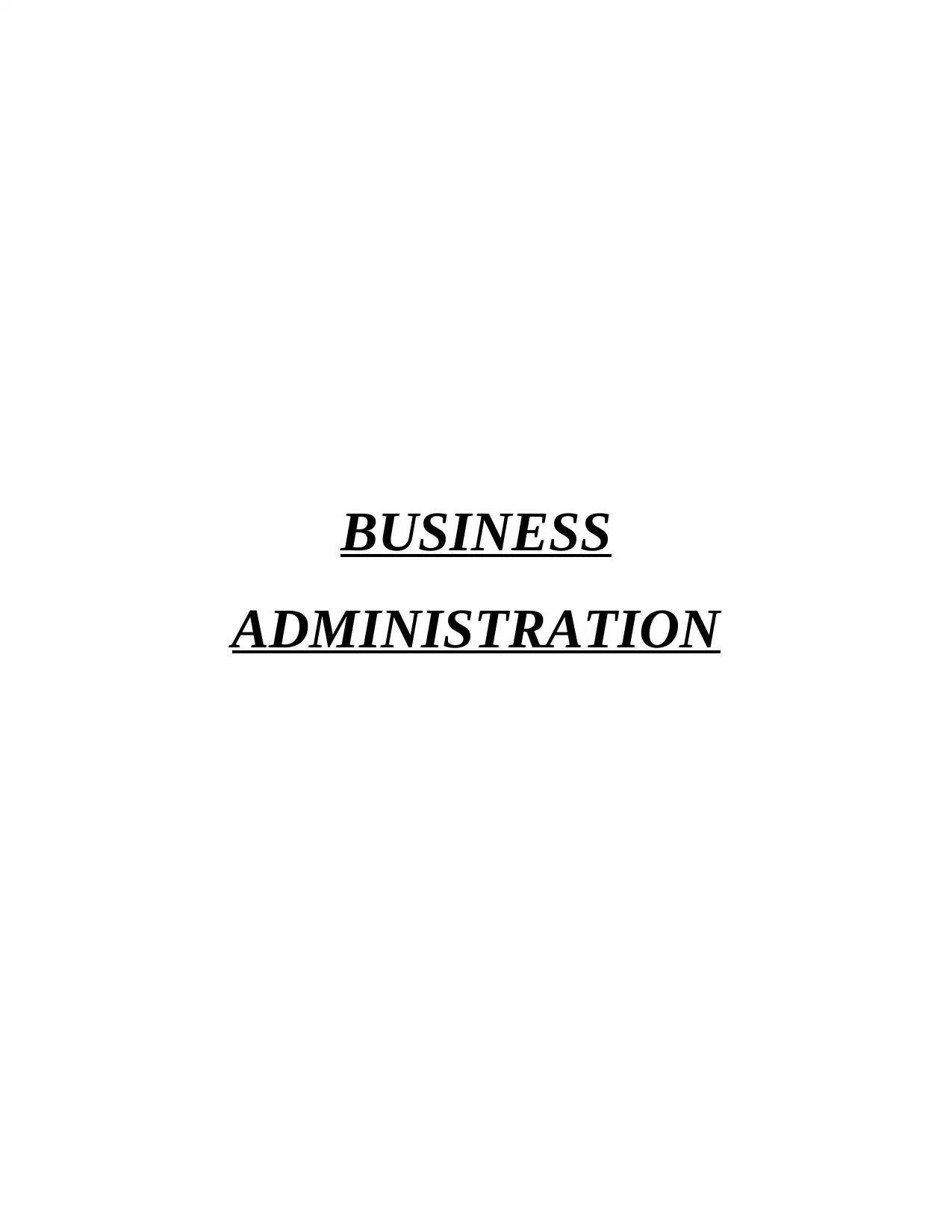
BUSINESS
ADMINISTRATION
ADMINISTRATION
Paraphrase This Document
Need a fresh take? Get an instant paraphrase of this document with our AI Paraphraser
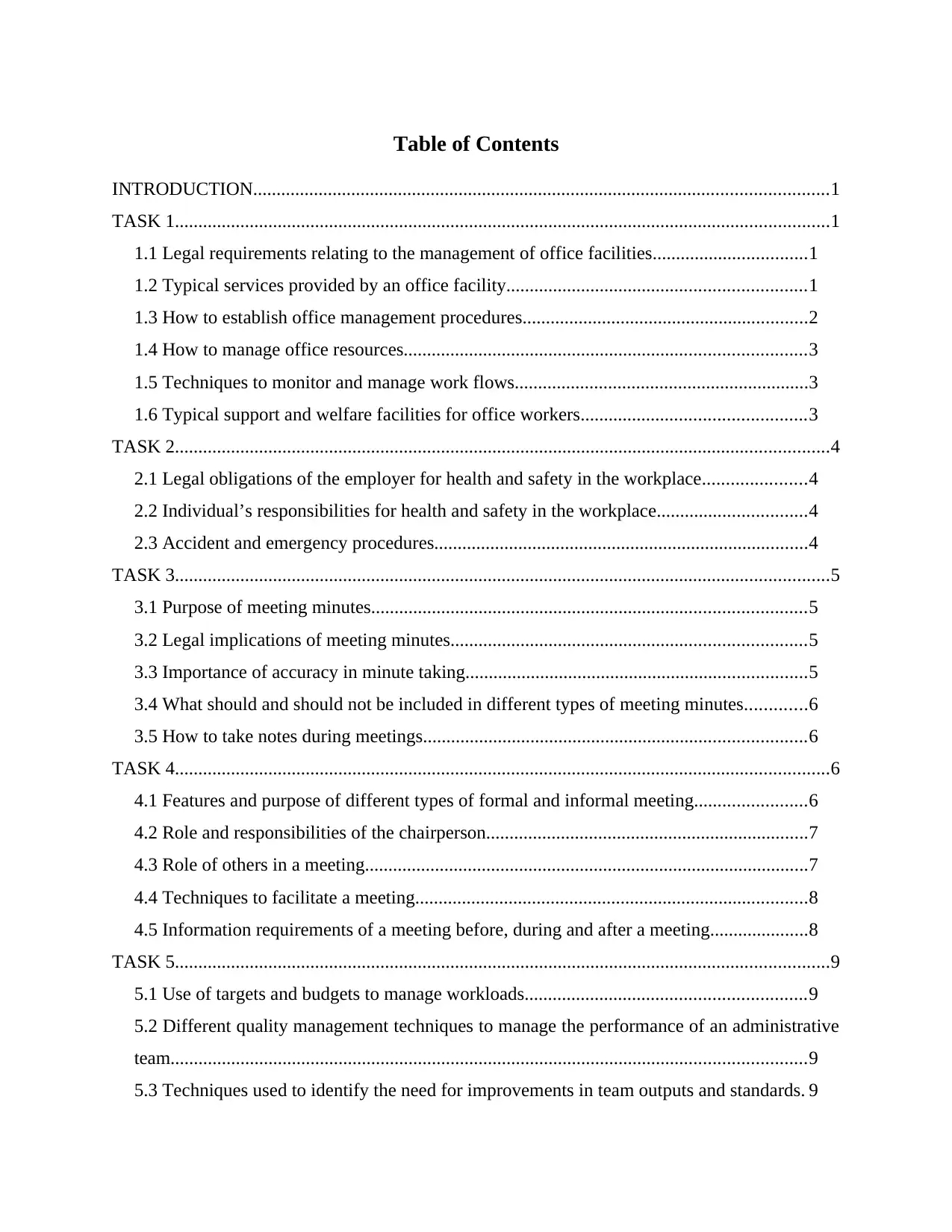
Table of Contents
INTRODUCTION...........................................................................................................................1
TASK 1............................................................................................................................................1
1.1 Legal requirements relating to the management of office facilities.................................1
1.2 Typical services provided by an office facility................................................................1
1.3 How to establish office management procedures.............................................................2
1.4 How to manage office resources......................................................................................3
1.5 Techniques to monitor and manage work flows...............................................................3
1.6 Typical support and welfare facilities for office workers................................................3
TASK 2............................................................................................................................................4
2.1 Legal obligations of the employer for health and safety in the workplace......................4
2.2 Individual’s responsibilities for health and safety in the workplace................................4
2.3 Accident and emergency procedures................................................................................4
TASK 3............................................................................................................................................5
3.1 Purpose of meeting minutes.............................................................................................5
3.2 Legal implications of meeting minutes............................................................................5
3.3 Importance of accuracy in minute taking.........................................................................5
3.4 What should and should not be included in different types of meeting minutes.............6
3.5 How to take notes during meetings..................................................................................6
TASK 4............................................................................................................................................6
4.1 Features and purpose of different types of formal and informal meeting........................6
4.2 Role and responsibilities of the chairperson.....................................................................7
4.3 Role of others in a meeting...............................................................................................7
4.4 Techniques to facilitate a meeting....................................................................................8
4.5 Information requirements of a meeting before, during and after a meeting.....................8
TASK 5............................................................................................................................................9
5.1 Use of targets and budgets to manage workloads............................................................9
5.2 Different quality management techniques to manage the performance of an administrative
team........................................................................................................................................9
5.3 Techniques used to identify the need for improvements in team outputs and standards. 9
INTRODUCTION...........................................................................................................................1
TASK 1............................................................................................................................................1
1.1 Legal requirements relating to the management of office facilities.................................1
1.2 Typical services provided by an office facility................................................................1
1.3 How to establish office management procedures.............................................................2
1.4 How to manage office resources......................................................................................3
1.5 Techniques to monitor and manage work flows...............................................................3
1.6 Typical support and welfare facilities for office workers................................................3
TASK 2............................................................................................................................................4
2.1 Legal obligations of the employer for health and safety in the workplace......................4
2.2 Individual’s responsibilities for health and safety in the workplace................................4
2.3 Accident and emergency procedures................................................................................4
TASK 3............................................................................................................................................5
3.1 Purpose of meeting minutes.............................................................................................5
3.2 Legal implications of meeting minutes............................................................................5
3.3 Importance of accuracy in minute taking.........................................................................5
3.4 What should and should not be included in different types of meeting minutes.............6
3.5 How to take notes during meetings..................................................................................6
TASK 4............................................................................................................................................6
4.1 Features and purpose of different types of formal and informal meeting........................6
4.2 Role and responsibilities of the chairperson.....................................................................7
4.3 Role of others in a meeting...............................................................................................7
4.4 Techniques to facilitate a meeting....................................................................................8
4.5 Information requirements of a meeting before, during and after a meeting.....................8
TASK 5............................................................................................................................................9
5.1 Use of targets and budgets to manage workloads............................................................9
5.2 Different quality management techniques to manage the performance of an administrative
team........................................................................................................................................9
5.3 Techniques used to identify the need for improvements in team outputs and standards. 9
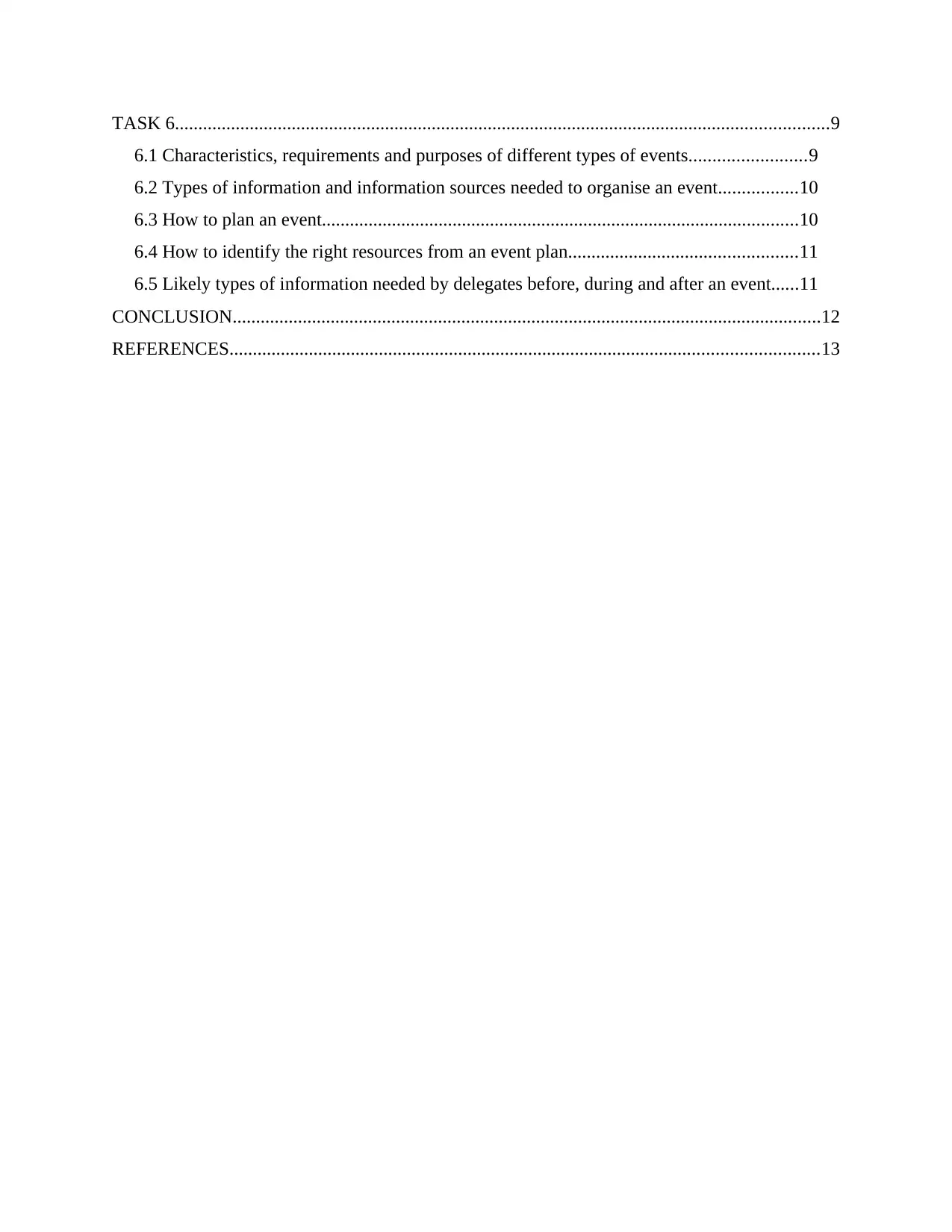
TASK 6............................................................................................................................................9
6.1 Characteristics, requirements and purposes of different types of events.........................9
6.2 Types of information and information sources needed to organise an event.................10
6.3 How to plan an event......................................................................................................10
6.4 How to identify the right resources from an event plan.................................................11
6.5 Likely types of information needed by delegates before, during and after an event......11
CONCLUSION..............................................................................................................................12
REFERENCES..............................................................................................................................13
6.1 Characteristics, requirements and purposes of different types of events.........................9
6.2 Types of information and information sources needed to organise an event.................10
6.3 How to plan an event......................................................................................................10
6.4 How to identify the right resources from an event plan.................................................11
6.5 Likely types of information needed by delegates before, during and after an event......11
CONCLUSION..............................................................................................................................12
REFERENCES..............................................................................................................................13
⊘ This is a preview!⊘
Do you want full access?
Subscribe today to unlock all pages.

Trusted by 1+ million students worldwide
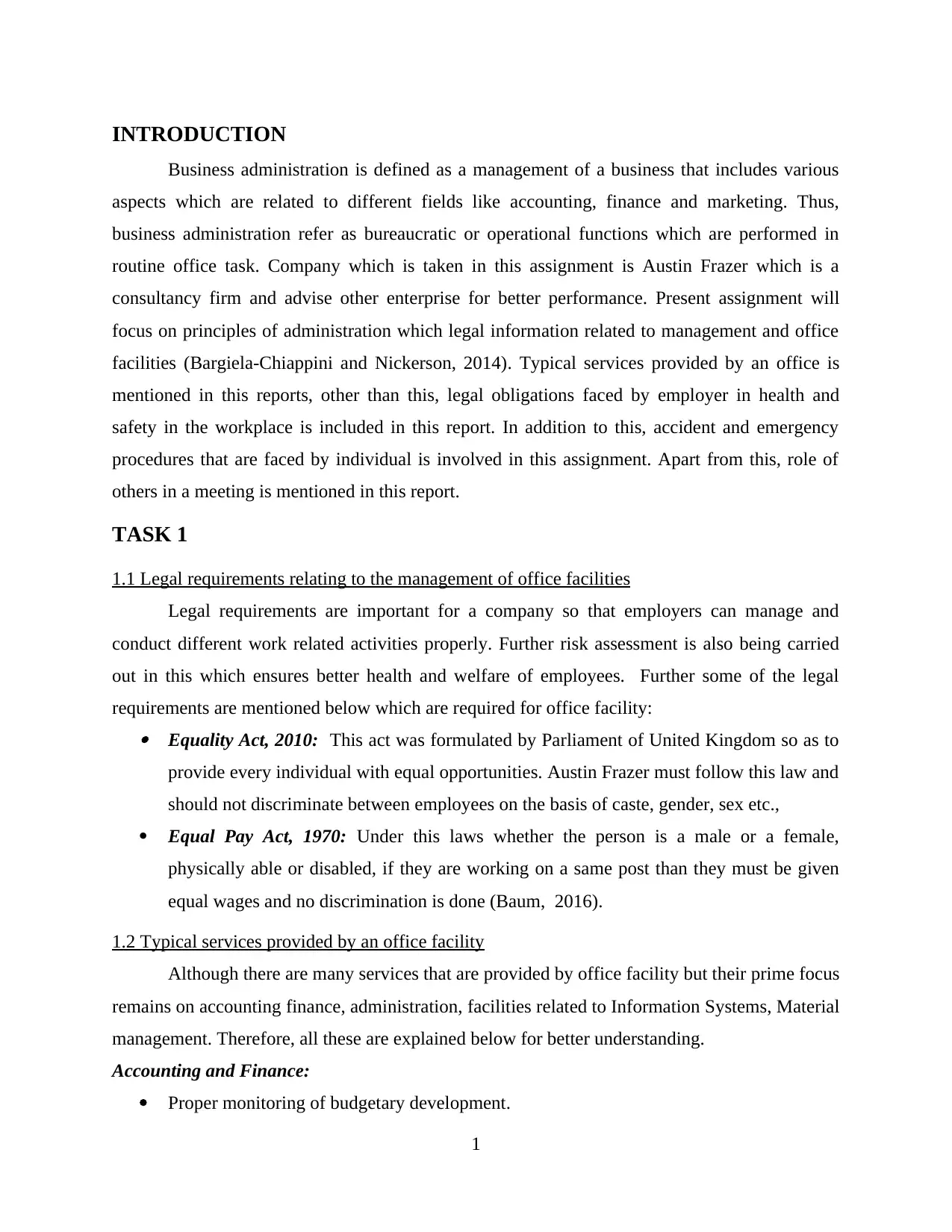
INTRODUCTION
Business administration is defined as a management of a business that includes various
aspects which are related to different fields like accounting, finance and marketing. Thus,
business administration refer as bureaucratic or operational functions which are performed in
routine office task. Company which is taken in this assignment is Austin Frazer which is a
consultancy firm and advise other enterprise for better performance. Present assignment will
focus on principles of administration which legal information related to management and office
facilities (Bargiela-Chiappini and Nickerson, 2014). Typical services provided by an office is
mentioned in this reports, other than this, legal obligations faced by employer in health and
safety in the workplace is included in this report. In addition to this, accident and emergency
procedures that are faced by individual is involved in this assignment. Apart from this, role of
others in a meeting is mentioned in this report.
TASK 1
1.1 Legal requirements relating to the management of office facilities
Legal requirements are important for a company so that employers can manage and
conduct different work related activities properly. Further risk assessment is also being carried
out in this which ensures better health and welfare of employees. Further some of the legal
requirements are mentioned below which are required for office facility: Equality Act, 2010: This act was formulated by Parliament of United Kingdom so as to
provide every individual with equal opportunities. Austin Frazer must follow this law and
should not discriminate between employees on the basis of caste, gender, sex etc.,
Equal Pay Act, 1970: Under this laws whether the person is a male or a female,
physically able or disabled, if they are working on a same post than they must be given
equal wages and no discrimination is done (Baum, 2016).
1.2 Typical services provided by an office facility
Although there are many services that are provided by office facility but their prime focus
remains on accounting finance, administration, facilities related to Information Systems, Material
management. Therefore, all these are explained below for better understanding.
Accounting and Finance:
Proper monitoring of budgetary development.
1
Business administration is defined as a management of a business that includes various
aspects which are related to different fields like accounting, finance and marketing. Thus,
business administration refer as bureaucratic or operational functions which are performed in
routine office task. Company which is taken in this assignment is Austin Frazer which is a
consultancy firm and advise other enterprise for better performance. Present assignment will
focus on principles of administration which legal information related to management and office
facilities (Bargiela-Chiappini and Nickerson, 2014). Typical services provided by an office is
mentioned in this reports, other than this, legal obligations faced by employer in health and
safety in the workplace is included in this report. In addition to this, accident and emergency
procedures that are faced by individual is involved in this assignment. Apart from this, role of
others in a meeting is mentioned in this report.
TASK 1
1.1 Legal requirements relating to the management of office facilities
Legal requirements are important for a company so that employers can manage and
conduct different work related activities properly. Further risk assessment is also being carried
out in this which ensures better health and welfare of employees. Further some of the legal
requirements are mentioned below which are required for office facility: Equality Act, 2010: This act was formulated by Parliament of United Kingdom so as to
provide every individual with equal opportunities. Austin Frazer must follow this law and
should not discriminate between employees on the basis of caste, gender, sex etc.,
Equal Pay Act, 1970: Under this laws whether the person is a male or a female,
physically able or disabled, if they are working on a same post than they must be given
equal wages and no discrimination is done (Baum, 2016).
1.2 Typical services provided by an office facility
Although there are many services that are provided by office facility but their prime focus
remains on accounting finance, administration, facilities related to Information Systems, Material
management. Therefore, all these are explained below for better understanding.
Accounting and Finance:
Proper monitoring of budgetary development.
1
Paraphrase This Document
Need a fresh take? Get an instant paraphrase of this document with our AI Paraphraser
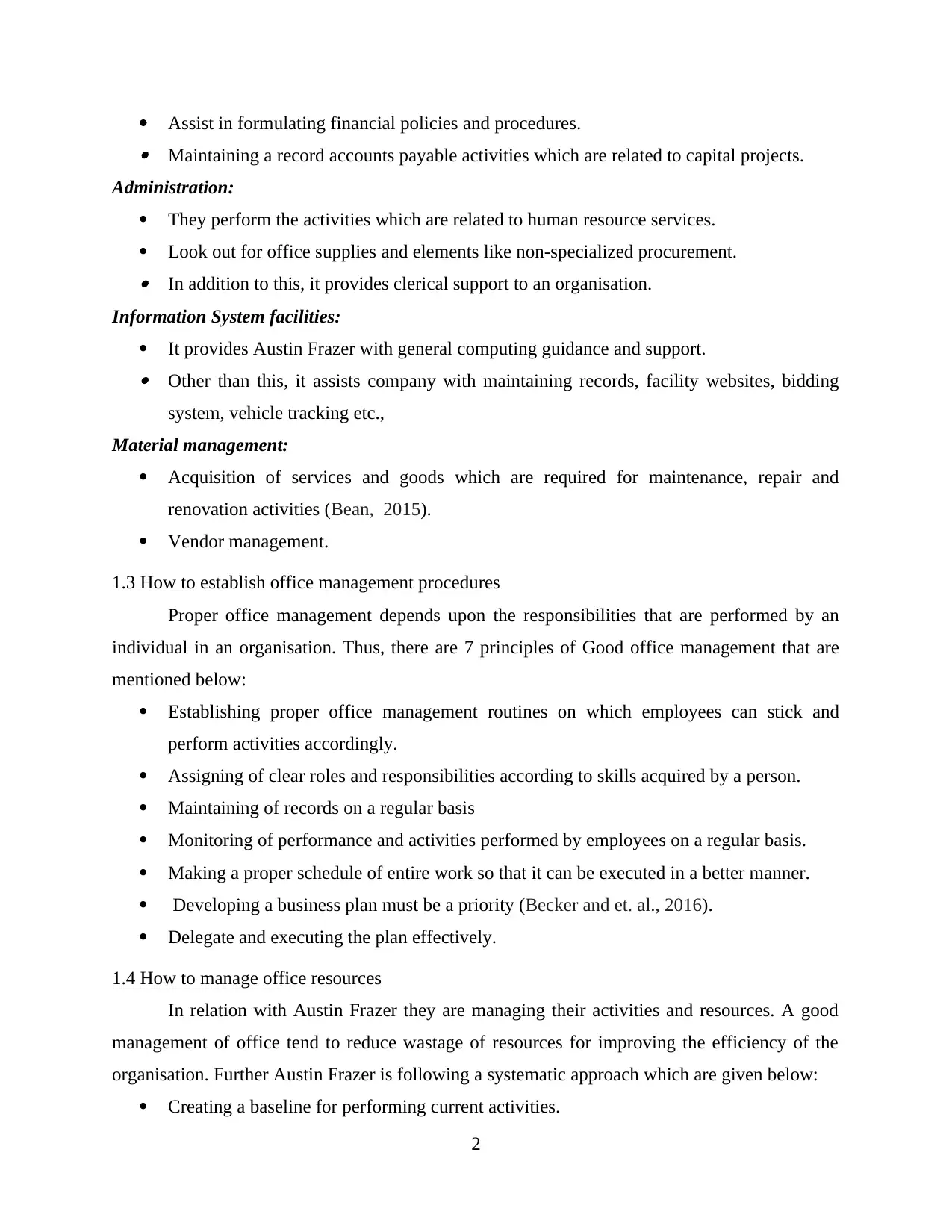
Assist in formulating financial policies and procedures. Maintaining a record accounts payable activities which are related to capital projects.
Administration:
They perform the activities which are related to human resource services.
Look out for office supplies and elements like non-specialized procurement. In addition to this, it provides clerical support to an organisation.
Information System facilities:
It provides Austin Frazer with general computing guidance and support. Other than this, it assists company with maintaining records, facility websites, bidding
system, vehicle tracking etc.,
Material management:
Acquisition of services and goods which are required for maintenance, repair and
renovation activities (Bean, 2015).
Vendor management.
1.3 How to establish office management procedures
Proper office management depends upon the responsibilities that are performed by an
individual in an organisation. Thus, there are 7 principles of Good office management that are
mentioned below:
Establishing proper office management routines on which employees can stick and
perform activities accordingly.
Assigning of clear roles and responsibilities according to skills acquired by a person.
Maintaining of records on a regular basis
Monitoring of performance and activities performed by employees on a regular basis.
Making a proper schedule of entire work so that it can be executed in a better manner.
Developing a business plan must be a priority (Becker and et. al., 2016).
Delegate and executing the plan effectively.
1.4 How to manage office resources
In relation with Austin Frazer they are managing their activities and resources. A good
management of office tend to reduce wastage of resources for improving the efficiency of the
organisation. Further Austin Frazer is following a systematic approach which are given below:
Creating a baseline for performing current activities.
2
Administration:
They perform the activities which are related to human resource services.
Look out for office supplies and elements like non-specialized procurement. In addition to this, it provides clerical support to an organisation.
Information System facilities:
It provides Austin Frazer with general computing guidance and support. Other than this, it assists company with maintaining records, facility websites, bidding
system, vehicle tracking etc.,
Material management:
Acquisition of services and goods which are required for maintenance, repair and
renovation activities (Bean, 2015).
Vendor management.
1.3 How to establish office management procedures
Proper office management depends upon the responsibilities that are performed by an
individual in an organisation. Thus, there are 7 principles of Good office management that are
mentioned below:
Establishing proper office management routines on which employees can stick and
perform activities accordingly.
Assigning of clear roles and responsibilities according to skills acquired by a person.
Maintaining of records on a regular basis
Monitoring of performance and activities performed by employees on a regular basis.
Making a proper schedule of entire work so that it can be executed in a better manner.
Developing a business plan must be a priority (Becker and et. al., 2016).
Delegate and executing the plan effectively.
1.4 How to manage office resources
In relation with Austin Frazer they are managing their activities and resources. A good
management of office tend to reduce wastage of resources for improving the efficiency of the
organisation. Further Austin Frazer is following a systematic approach which are given below:
Creating a baseline for performing current activities.
2
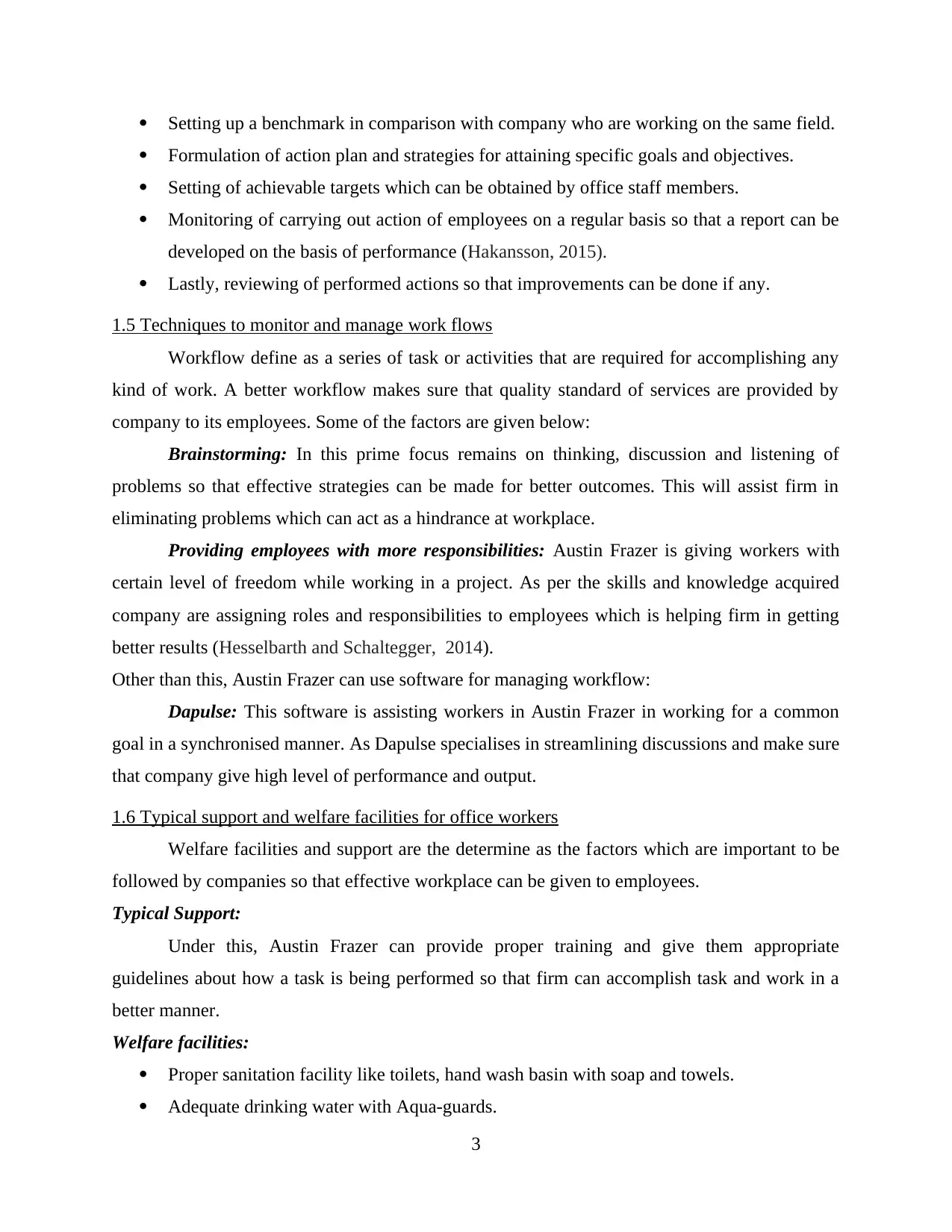
Setting up a benchmark in comparison with company who are working on the same field.
Formulation of action plan and strategies for attaining specific goals and objectives.
Setting of achievable targets which can be obtained by office staff members.
Monitoring of carrying out action of employees on a regular basis so that a report can be
developed on the basis of performance (Hakansson, 2015).
Lastly, reviewing of performed actions so that improvements can be done if any.
1.5 Techniques to monitor and manage work flows
Workflow define as a series of task or activities that are required for accomplishing any
kind of work. A better workflow makes sure that quality standard of services are provided by
company to its employees. Some of the factors are given below:
Brainstorming: In this prime focus remains on thinking, discussion and listening of
problems so that effective strategies can be made for better outcomes. This will assist firm in
eliminating problems which can act as a hindrance at workplace.
Providing employees with more responsibilities: Austin Frazer is giving workers with
certain level of freedom while working in a project. As per the skills and knowledge acquired
company are assigning roles and responsibilities to employees which is helping firm in getting
better results (Hesselbarth and Schaltegger, 2014).
Other than this, Austin Frazer can use software for managing workflow:
Dapulse: This software is assisting workers in Austin Frazer in working for a common
goal in a synchronised manner. As Dapulse specialises in streamlining discussions and make sure
that company give high level of performance and output.
1.6 Typical support and welfare facilities for office workers
Welfare facilities and support are the determine as the factors which are important to be
followed by companies so that effective workplace can be given to employees.
Typical Support:
Under this, Austin Frazer can provide proper training and give them appropriate
guidelines about how a task is being performed so that firm can accomplish task and work in a
better manner.
Welfare facilities:
Proper sanitation facility like toilets, hand wash basin with soap and towels.
Adequate drinking water with Aqua-guards.
3
Formulation of action plan and strategies for attaining specific goals and objectives.
Setting of achievable targets which can be obtained by office staff members.
Monitoring of carrying out action of employees on a regular basis so that a report can be
developed on the basis of performance (Hakansson, 2015).
Lastly, reviewing of performed actions so that improvements can be done if any.
1.5 Techniques to monitor and manage work flows
Workflow define as a series of task or activities that are required for accomplishing any
kind of work. A better workflow makes sure that quality standard of services are provided by
company to its employees. Some of the factors are given below:
Brainstorming: In this prime focus remains on thinking, discussion and listening of
problems so that effective strategies can be made for better outcomes. This will assist firm in
eliminating problems which can act as a hindrance at workplace.
Providing employees with more responsibilities: Austin Frazer is giving workers with
certain level of freedom while working in a project. As per the skills and knowledge acquired
company are assigning roles and responsibilities to employees which is helping firm in getting
better results (Hesselbarth and Schaltegger, 2014).
Other than this, Austin Frazer can use software for managing workflow:
Dapulse: This software is assisting workers in Austin Frazer in working for a common
goal in a synchronised manner. As Dapulse specialises in streamlining discussions and make sure
that company give high level of performance and output.
1.6 Typical support and welfare facilities for office workers
Welfare facilities and support are the determine as the factors which are important to be
followed by companies so that effective workplace can be given to employees.
Typical Support:
Under this, Austin Frazer can provide proper training and give them appropriate
guidelines about how a task is being performed so that firm can accomplish task and work in a
better manner.
Welfare facilities:
Proper sanitation facility like toilets, hand wash basin with soap and towels.
Adequate drinking water with Aqua-guards.
3
⊘ This is a preview!⊘
Do you want full access?
Subscribe today to unlock all pages.

Trusted by 1+ million students worldwide
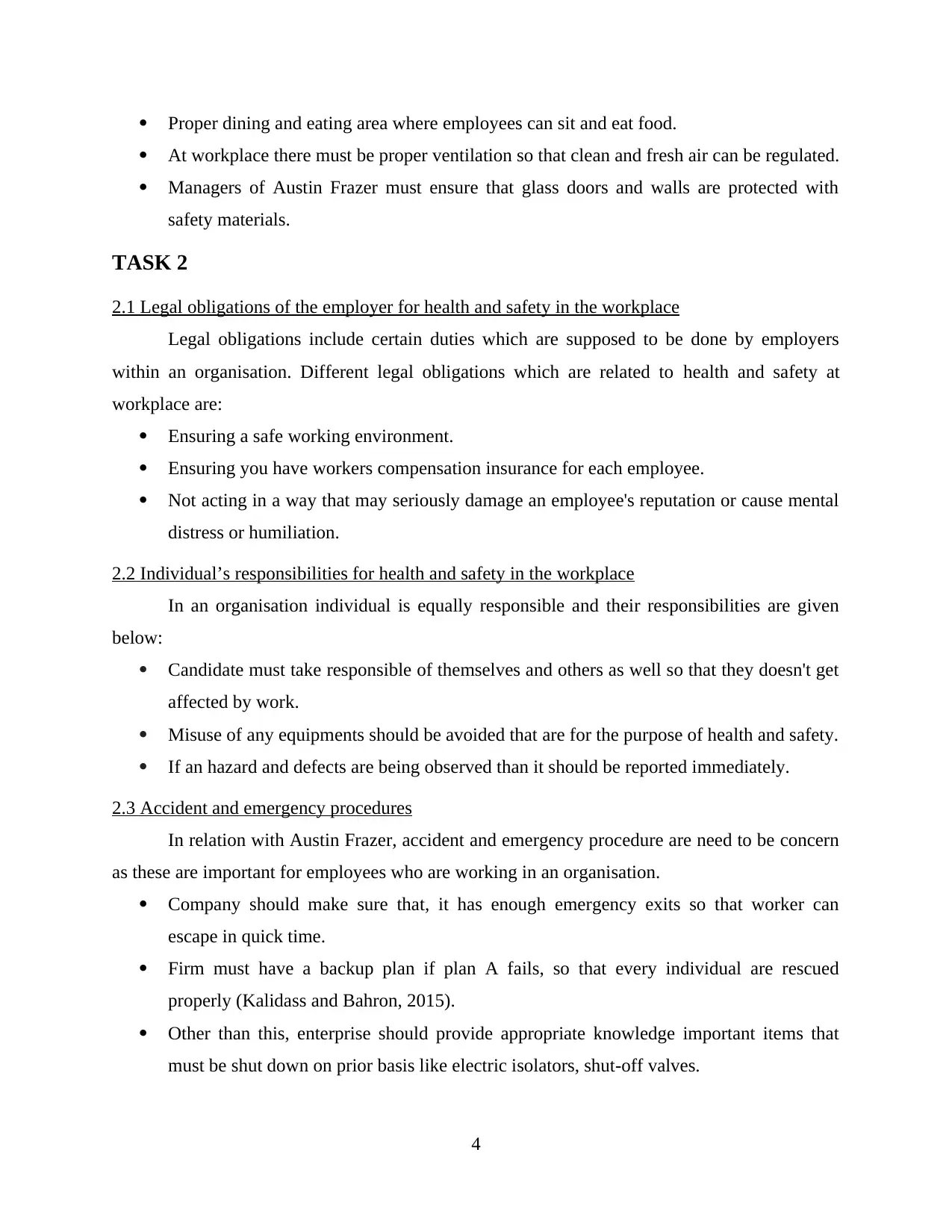
Proper dining and eating area where employees can sit and eat food.
At workplace there must be proper ventilation so that clean and fresh air can be regulated.
Managers of Austin Frazer must ensure that glass doors and walls are protected with
safety materials.
TASK 2
2.1 Legal obligations of the employer for health and safety in the workplace
Legal obligations include certain duties which are supposed to be done by employers
within an organisation. Different legal obligations which are related to health and safety at
workplace are:
Ensuring a safe working environment.
Ensuring you have workers compensation insurance for each employee.
Not acting in a way that may seriously damage an employee's reputation or cause mental
distress or humiliation.
2.2 Individual’s responsibilities for health and safety in the workplace
In an organisation individual is equally responsible and their responsibilities are given
below:
Candidate must take responsible of themselves and others as well so that they doesn't get
affected by work.
Misuse of any equipments should be avoided that are for the purpose of health and safety.
If an hazard and defects are being observed than it should be reported immediately.
2.3 Accident and emergency procedures
In relation with Austin Frazer, accident and emergency procedure are need to be concern
as these are important for employees who are working in an organisation.
Company should make sure that, it has enough emergency exits so that worker can
escape in quick time.
Firm must have a backup plan if plan A fails, so that every individual are rescued
properly (Kalidass and Bahron, 2015).
Other than this, enterprise should provide appropriate knowledge important items that
must be shut down on prior basis like electric isolators, shut-off valves.
4
At workplace there must be proper ventilation so that clean and fresh air can be regulated.
Managers of Austin Frazer must ensure that glass doors and walls are protected with
safety materials.
TASK 2
2.1 Legal obligations of the employer for health and safety in the workplace
Legal obligations include certain duties which are supposed to be done by employers
within an organisation. Different legal obligations which are related to health and safety at
workplace are:
Ensuring a safe working environment.
Ensuring you have workers compensation insurance for each employee.
Not acting in a way that may seriously damage an employee's reputation or cause mental
distress or humiliation.
2.2 Individual’s responsibilities for health and safety in the workplace
In an organisation individual is equally responsible and their responsibilities are given
below:
Candidate must take responsible of themselves and others as well so that they doesn't get
affected by work.
Misuse of any equipments should be avoided that are for the purpose of health and safety.
If an hazard and defects are being observed than it should be reported immediately.
2.3 Accident and emergency procedures
In relation with Austin Frazer, accident and emergency procedure are need to be concern
as these are important for employees who are working in an organisation.
Company should make sure that, it has enough emergency exits so that worker can
escape in quick time.
Firm must have a backup plan if plan A fails, so that every individual are rescued
properly (Kalidass and Bahron, 2015).
Other than this, enterprise should provide appropriate knowledge important items that
must be shut down on prior basis like electric isolators, shut-off valves.
4
Paraphrase This Document
Need a fresh take? Get an instant paraphrase of this document with our AI Paraphraser
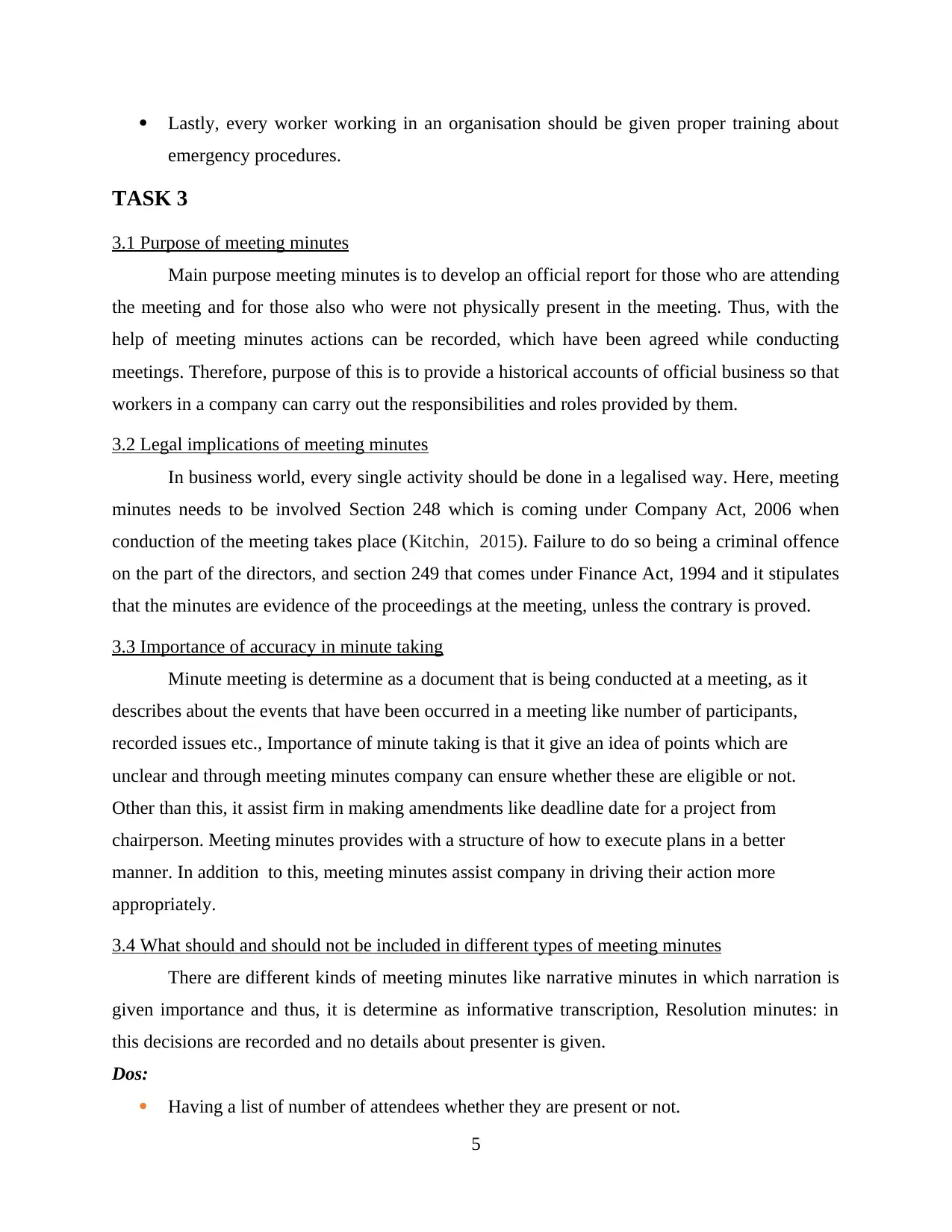
Lastly, every worker working in an organisation should be given proper training about
emergency procedures.
TASK 3
3.1 Purpose of meeting minutes
Main purpose meeting minutes is to develop an official report for those who are attending
the meeting and for those also who were not physically present in the meeting. Thus, with the
help of meeting minutes actions can be recorded, which have been agreed while conducting
meetings. Therefore, purpose of this is to provide a historical accounts of official business so that
workers in a company can carry out the responsibilities and roles provided by them.
3.2 Legal implications of meeting minutes
In business world, every single activity should be done in a legalised way. Here, meeting
minutes needs to be involved Section 248 which is coming under Company Act, 2006 when
conduction of the meeting takes place (Kitchin, 2015). Failure to do so being a criminal offence
on the part of the directors, and section 249 that comes under Finance Act, 1994 and it stipulates
that the minutes are evidence of the proceedings at the meeting, unless the contrary is proved.
3.3 Importance of accuracy in minute taking
Minute meeting is determine as a document that is being conducted at a meeting, as it
describes about the events that have been occurred in a meeting like number of participants,
recorded issues etc., Importance of minute taking is that it give an idea of points which are
unclear and through meeting minutes company can ensure whether these are eligible or not.
Other than this, it assist firm in making amendments like deadline date for a project from
chairperson. Meeting minutes provides with a structure of how to execute plans in a better
manner. In addition to this, meeting minutes assist company in driving their action more
appropriately.
3.4 What should and should not be included in different types of meeting minutes
There are different kinds of meeting minutes like narrative minutes in which narration is
given importance and thus, it is determine as informative transcription, Resolution minutes: in
this decisions are recorded and no details about presenter is given.
Dos:
Having a list of number of attendees whether they are present or not.
5
emergency procedures.
TASK 3
3.1 Purpose of meeting minutes
Main purpose meeting minutes is to develop an official report for those who are attending
the meeting and for those also who were not physically present in the meeting. Thus, with the
help of meeting minutes actions can be recorded, which have been agreed while conducting
meetings. Therefore, purpose of this is to provide a historical accounts of official business so that
workers in a company can carry out the responsibilities and roles provided by them.
3.2 Legal implications of meeting minutes
In business world, every single activity should be done in a legalised way. Here, meeting
minutes needs to be involved Section 248 which is coming under Company Act, 2006 when
conduction of the meeting takes place (Kitchin, 2015). Failure to do so being a criminal offence
on the part of the directors, and section 249 that comes under Finance Act, 1994 and it stipulates
that the minutes are evidence of the proceedings at the meeting, unless the contrary is proved.
3.3 Importance of accuracy in minute taking
Minute meeting is determine as a document that is being conducted at a meeting, as it
describes about the events that have been occurred in a meeting like number of participants,
recorded issues etc., Importance of minute taking is that it give an idea of points which are
unclear and through meeting minutes company can ensure whether these are eligible or not.
Other than this, it assist firm in making amendments like deadline date for a project from
chairperson. Meeting minutes provides with a structure of how to execute plans in a better
manner. In addition to this, meeting minutes assist company in driving their action more
appropriately.
3.4 What should and should not be included in different types of meeting minutes
There are different kinds of meeting minutes like narrative minutes in which narration is
given importance and thus, it is determine as informative transcription, Resolution minutes: in
this decisions are recorded and no details about presenter is given.
Dos:
Having a list of number of attendees whether they are present or not.
5
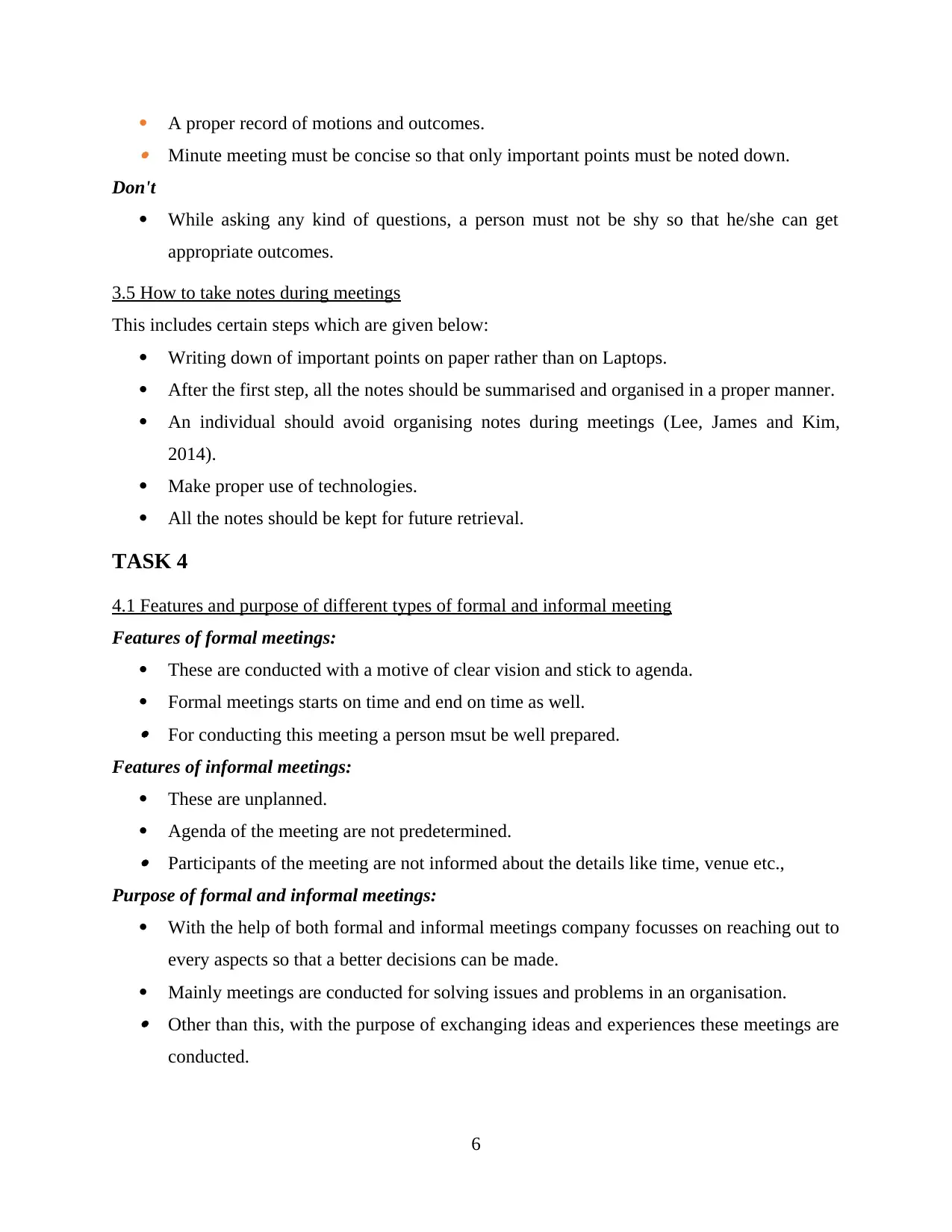
A proper record of motions and outcomes. Minute meeting must be concise so that only important points must be noted down.
Don't
While asking any kind of questions, a person must not be shy so that he/she can get
appropriate outcomes.
3.5 How to take notes during meetings
This includes certain steps which are given below:
Writing down of important points on paper rather than on Laptops.
After the first step, all the notes should be summarised and organised in a proper manner.
An individual should avoid organising notes during meetings (Lee, James and Kim,
2014).
Make proper use of technologies.
All the notes should be kept for future retrieval.
TASK 4
4.1 Features and purpose of different types of formal and informal meeting
Features of formal meetings:
These are conducted with a motive of clear vision and stick to agenda.
Formal meetings starts on time and end on time as well. For conducting this meeting a person msut be well prepared.
Features of informal meetings:
These are unplanned.
Agenda of the meeting are not predetermined. Participants of the meeting are not informed about the details like time, venue etc.,
Purpose of formal and informal meetings:
With the help of both formal and informal meetings company focusses on reaching out to
every aspects so that a better decisions can be made.
Mainly meetings are conducted for solving issues and problems in an organisation. Other than this, with the purpose of exchanging ideas and experiences these meetings are
conducted.
6
Don't
While asking any kind of questions, a person must not be shy so that he/she can get
appropriate outcomes.
3.5 How to take notes during meetings
This includes certain steps which are given below:
Writing down of important points on paper rather than on Laptops.
After the first step, all the notes should be summarised and organised in a proper manner.
An individual should avoid organising notes during meetings (Lee, James and Kim,
2014).
Make proper use of technologies.
All the notes should be kept for future retrieval.
TASK 4
4.1 Features and purpose of different types of formal and informal meeting
Features of formal meetings:
These are conducted with a motive of clear vision and stick to agenda.
Formal meetings starts on time and end on time as well. For conducting this meeting a person msut be well prepared.
Features of informal meetings:
These are unplanned.
Agenda of the meeting are not predetermined. Participants of the meeting are not informed about the details like time, venue etc.,
Purpose of formal and informal meetings:
With the help of both formal and informal meetings company focusses on reaching out to
every aspects so that a better decisions can be made.
Mainly meetings are conducted for solving issues and problems in an organisation. Other than this, with the purpose of exchanging ideas and experiences these meetings are
conducted.
6
⊘ This is a preview!⊘
Do you want full access?
Subscribe today to unlock all pages.

Trusted by 1+ million students worldwide
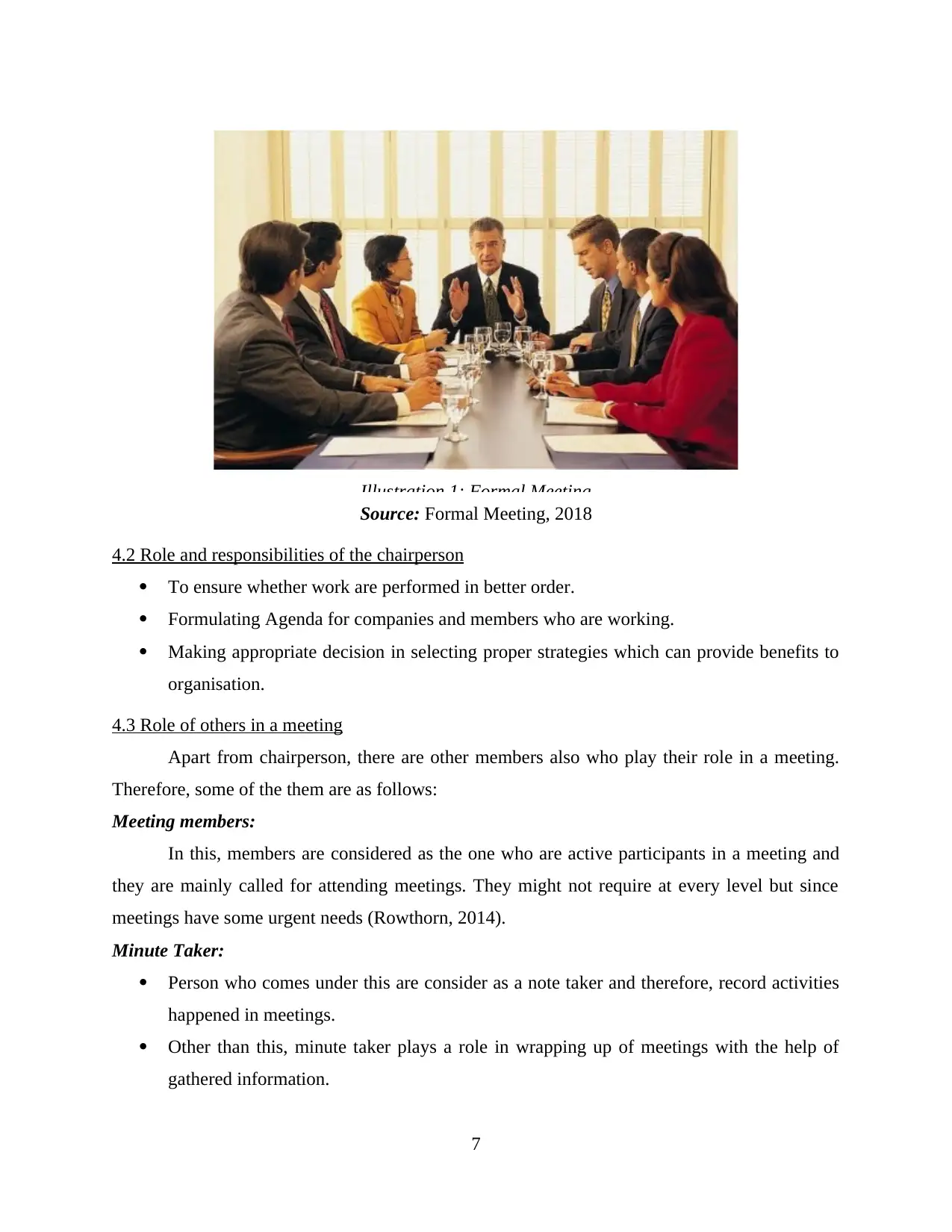
Source: Formal Meeting, 2018
4.2 Role and responsibilities of the chairperson
To ensure whether work are performed in better order.
Formulating Agenda for companies and members who are working.
Making appropriate decision in selecting proper strategies which can provide benefits to
organisation.
4.3 Role of others in a meeting
Apart from chairperson, there are other members also who play their role in a meeting.
Therefore, some of the them are as follows:
Meeting members:
In this, members are considered as the one who are active participants in a meeting and
they are mainly called for attending meetings. They might not require at every level but since
meetings have some urgent needs (Rowthorn, 2014).
Minute Taker:
Person who comes under this are consider as a note taker and therefore, record activities
happened in meetings.
Other than this, minute taker plays a role in wrapping up of meetings with the help of
gathered information.
7
Illustration 1: Formal Meeting
4.2 Role and responsibilities of the chairperson
To ensure whether work are performed in better order.
Formulating Agenda for companies and members who are working.
Making appropriate decision in selecting proper strategies which can provide benefits to
organisation.
4.3 Role of others in a meeting
Apart from chairperson, there are other members also who play their role in a meeting.
Therefore, some of the them are as follows:
Meeting members:
In this, members are considered as the one who are active participants in a meeting and
they are mainly called for attending meetings. They might not require at every level but since
meetings have some urgent needs (Rowthorn, 2014).
Minute Taker:
Person who comes under this are consider as a note taker and therefore, record activities
happened in meetings.
Other than this, minute taker plays a role in wrapping up of meetings with the help of
gathered information.
7
Illustration 1: Formal Meeting
Paraphrase This Document
Need a fresh take? Get an instant paraphrase of this document with our AI Paraphraser
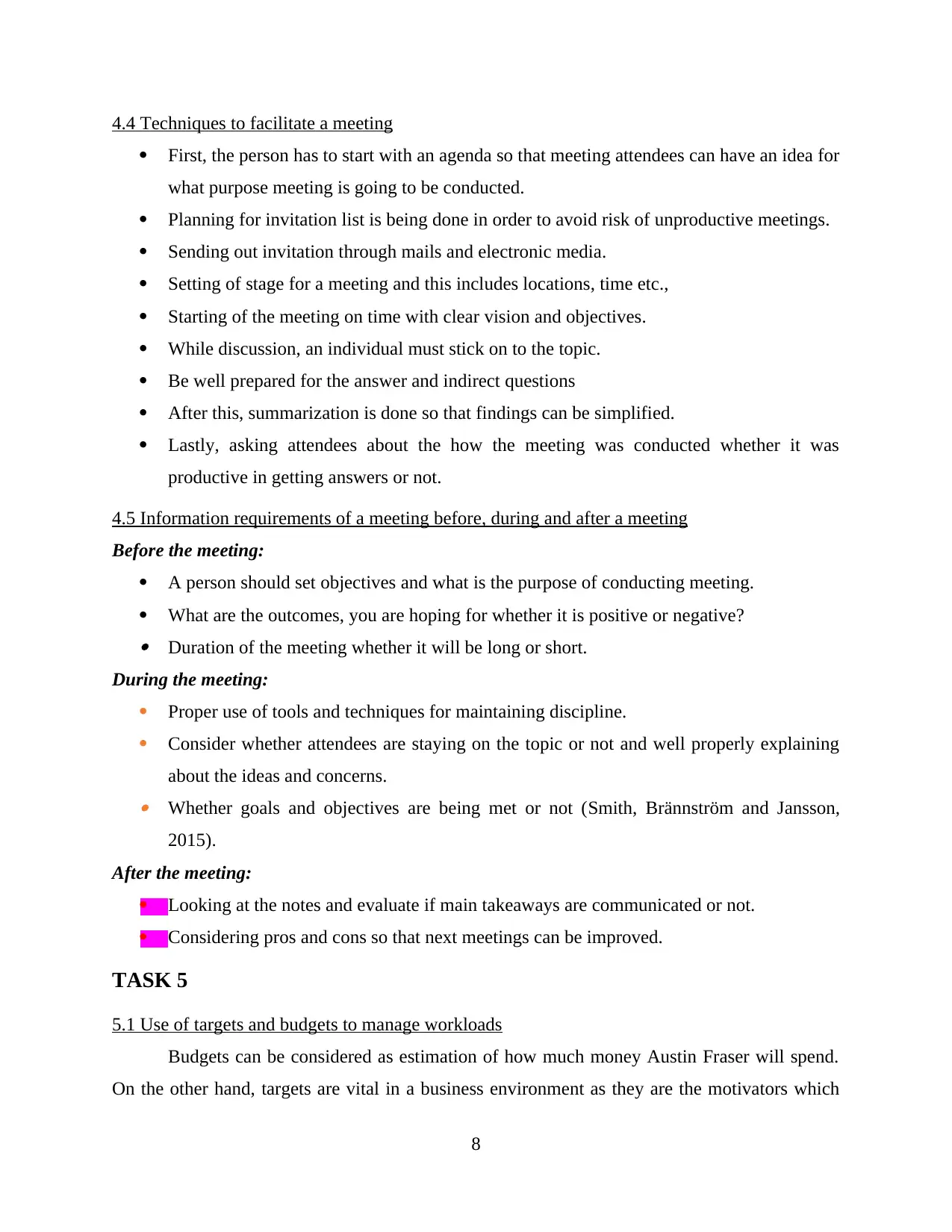
4.4 Techniques to facilitate a meeting
First, the person has to start with an agenda so that meeting attendees can have an idea for
what purpose meeting is going to be conducted.
Planning for invitation list is being done in order to avoid risk of unproductive meetings.
Sending out invitation through mails and electronic media.
Setting of stage for a meeting and this includes locations, time etc.,
Starting of the meeting on time with clear vision and objectives.
While discussion, an individual must stick on to the topic.
Be well prepared for the answer and indirect questions
After this, summarization is done so that findings can be simplified.
Lastly, asking attendees about the how the meeting was conducted whether it was
productive in getting answers or not.
4.5 Information requirements of a meeting before, during and after a meeting
Before the meeting:
A person should set objectives and what is the purpose of conducting meeting.
What are the outcomes, you are hoping for whether it is positive or negative? Duration of the meeting whether it will be long or short.
During the meeting:
Proper use of tools and techniques for maintaining discipline.
Consider whether attendees are staying on the topic or not and well properly explaining
about the ideas and concerns. Whether goals and objectives are being met or not (Smith, Brännström and Jansson,
2015).
After the meeting:
Looking at the notes and evaluate if main takeaways are communicated or not.
Considering pros and cons so that next meetings can be improved.
TASK 5
5.1 Use of targets and budgets to manage workloads
Budgets can be considered as estimation of how much money Austin Fraser will spend.
On the other hand, targets are vital in a business environment as they are the motivators which
8
First, the person has to start with an agenda so that meeting attendees can have an idea for
what purpose meeting is going to be conducted.
Planning for invitation list is being done in order to avoid risk of unproductive meetings.
Sending out invitation through mails and electronic media.
Setting of stage for a meeting and this includes locations, time etc.,
Starting of the meeting on time with clear vision and objectives.
While discussion, an individual must stick on to the topic.
Be well prepared for the answer and indirect questions
After this, summarization is done so that findings can be simplified.
Lastly, asking attendees about the how the meeting was conducted whether it was
productive in getting answers or not.
4.5 Information requirements of a meeting before, during and after a meeting
Before the meeting:
A person should set objectives and what is the purpose of conducting meeting.
What are the outcomes, you are hoping for whether it is positive or negative? Duration of the meeting whether it will be long or short.
During the meeting:
Proper use of tools and techniques for maintaining discipline.
Consider whether attendees are staying on the topic or not and well properly explaining
about the ideas and concerns. Whether goals and objectives are being met or not (Smith, Brännström and Jansson,
2015).
After the meeting:
Looking at the notes and evaluate if main takeaways are communicated or not.
Considering pros and cons so that next meetings can be improved.
TASK 5
5.1 Use of targets and budgets to manage workloads
Budgets can be considered as estimation of how much money Austin Fraser will spend.
On the other hand, targets are vital in a business environment as they are the motivators which
8
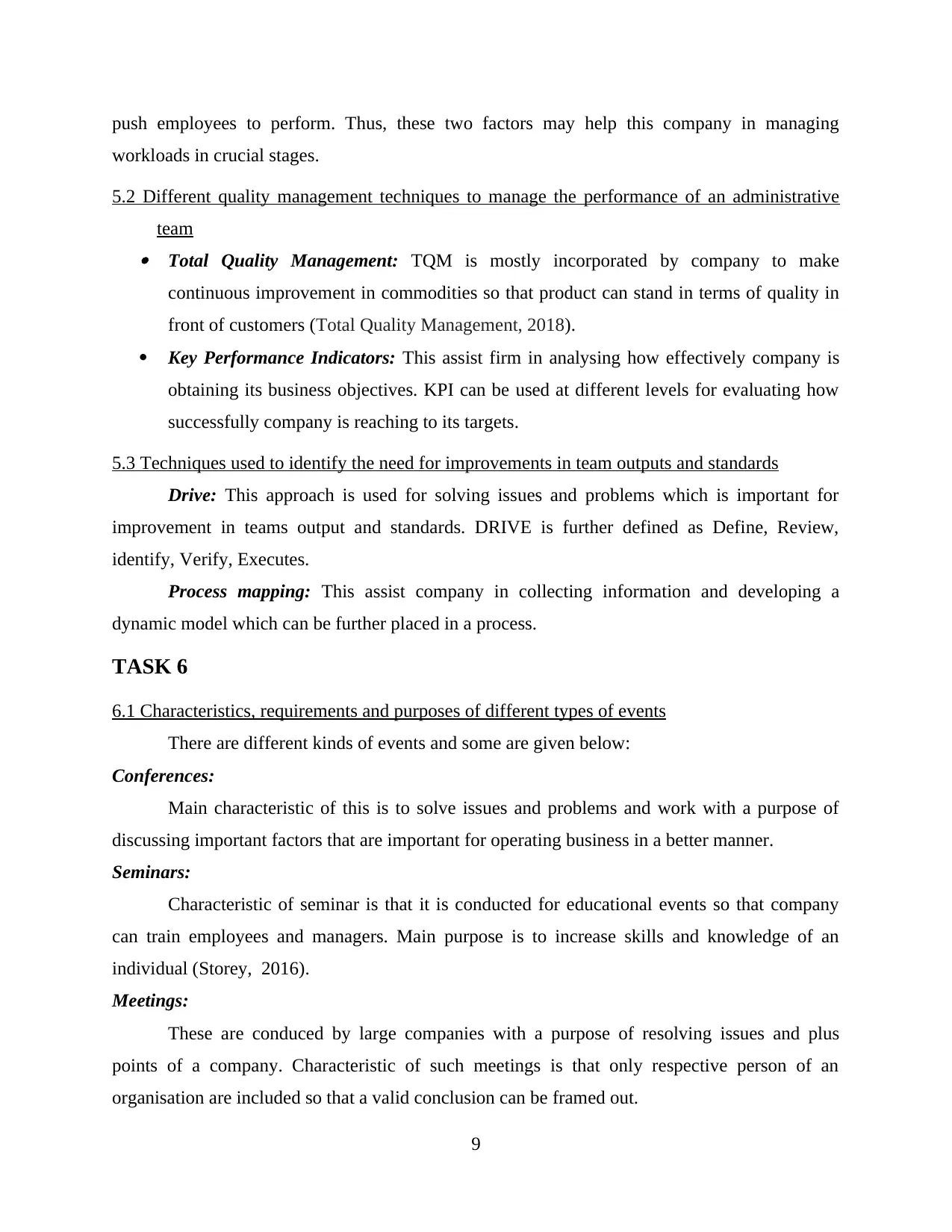
push employees to perform. Thus, these two factors may help this company in managing
workloads in crucial stages.
5.2 Different quality management techniques to manage the performance of an administrative
team Total Quality Management: TQM is mostly incorporated by company to make
continuous improvement in commodities so that product can stand in terms of quality in
front of customers (Total Quality Management, 2018).
Key Performance Indicators: This assist firm in analysing how effectively company is
obtaining its business objectives. KPI can be used at different levels for evaluating how
successfully company is reaching to its targets.
5.3 Techniques used to identify the need for improvements in team outputs and standards
Drive: This approach is used for solving issues and problems which is important for
improvement in teams output and standards. DRIVE is further defined as Define, Review,
identify, Verify, Executes.
Process mapping: This assist company in collecting information and developing a
dynamic model which can be further placed in a process.
TASK 6
6.1 Characteristics, requirements and purposes of different types of events
There are different kinds of events and some are given below:
Conferences:
Main characteristic of this is to solve issues and problems and work with a purpose of
discussing important factors that are important for operating business in a better manner.
Seminars:
Characteristic of seminar is that it is conducted for educational events so that company
can train employees and managers. Main purpose is to increase skills and knowledge of an
individual (Storey, 2016).
Meetings:
These are conduced by large companies with a purpose of resolving issues and plus
points of a company. Characteristic of such meetings is that only respective person of an
organisation are included so that a valid conclusion can be framed out.
9
workloads in crucial stages.
5.2 Different quality management techniques to manage the performance of an administrative
team Total Quality Management: TQM is mostly incorporated by company to make
continuous improvement in commodities so that product can stand in terms of quality in
front of customers (Total Quality Management, 2018).
Key Performance Indicators: This assist firm in analysing how effectively company is
obtaining its business objectives. KPI can be used at different levels for evaluating how
successfully company is reaching to its targets.
5.3 Techniques used to identify the need for improvements in team outputs and standards
Drive: This approach is used for solving issues and problems which is important for
improvement in teams output and standards. DRIVE is further defined as Define, Review,
identify, Verify, Executes.
Process mapping: This assist company in collecting information and developing a
dynamic model which can be further placed in a process.
TASK 6
6.1 Characteristics, requirements and purposes of different types of events
There are different kinds of events and some are given below:
Conferences:
Main characteristic of this is to solve issues and problems and work with a purpose of
discussing important factors that are important for operating business in a better manner.
Seminars:
Characteristic of seminar is that it is conducted for educational events so that company
can train employees and managers. Main purpose is to increase skills and knowledge of an
individual (Storey, 2016).
Meetings:
These are conduced by large companies with a purpose of resolving issues and plus
points of a company. Characteristic of such meetings is that only respective person of an
organisation are included so that a valid conclusion can be framed out.
9
⊘ This is a preview!⊘
Do you want full access?
Subscribe today to unlock all pages.

Trusted by 1+ million students worldwide
1 out of 15
Related Documents
Your All-in-One AI-Powered Toolkit for Academic Success.
+13062052269
info@desklib.com
Available 24*7 on WhatsApp / Email
![[object Object]](/_next/static/media/star-bottom.7253800d.svg)
Unlock your academic potential
Copyright © 2020–2025 A2Z Services. All Rights Reserved. Developed and managed by ZUCOL.




